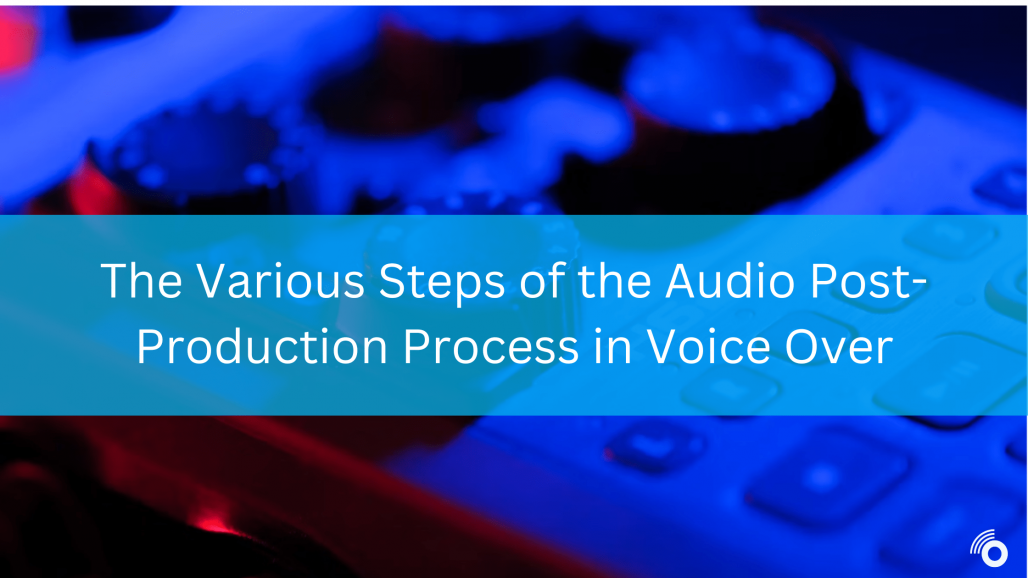Discover the latest voice-over industry trends 2025—from AI advancements to the growing demand for m...
The Various Steps of the Audio Post-Production Process in Voice Over

Audio can make or break a voice-over project. If your recording doesn’t have a good balance; for example, if you can’t hear the voice correctly or there is too much background noise, your audience can become distracted and have trouble understanding what you are trying to communicate.
This is why post-production is essential when working on a voice-over project. If you want to convince people to keep listening, you need to make sure your voice comes across clearly. This guide will cover everything you need to know about voice-over post-production, including its different techniques, its benefits, and a few tips so you can set yourself up for success.
What Is Post-Production?
Imagine you finish doing a voice-over recording for an advertisement but realise, later, that you accidentally leave the sound of a banging door or a barking dog in the background. With post-production, you have the chance to detect these issues and correct them, so all your audience hears are your intentional choices.
Post-production is, basically, everything you need to do after recording your voice-overs to ensure they are fit for purpose. This includes editing and timing your voice and adjusting flow and pace so you can create sound recordings for videos, podcasts, audiobooks, and commercials. In many cases, it also involves adding pauses and removing breaths, splicing, compressing, and fine-tuning your audio tracks.
The Different Audio Post-Production Techniques
Post-production consists of various techniques that go beyond removing mistakes and adding sound effects for transitions and such. For general audio post-production efforts, these are some of the most common post-production stages:
Sound Design
Sound design involves calibrating and planning audio tracks so you can add effects. If you are recording voice-overs, you are probably not going to be adding other effects yourself. This is a fundamental part of post-production if you work on certain types of recordings like audiobooks, movies, or music. Many sound designers like to add everyday sounds to voice-over tracks. For example, replicating steps and other effects that wouldn’t be easily captured in a set.
Mixing
Audio engineers mix tracks by bringing in numerous recorded elements. The art of combining these allows them to control and fine-tune how each of them interacts to create a good balance and flow. In voice-overs, mixing ensures the voice can be heard and takes precedence over any other tracks used.
Editing
When you edit a voice-over piece of audio, you typically assemble different takes so you can create dialogues and use music and effects (if needed). For example, if you use a text-to-speech script, you can use post-production editing to add strategic pauses.
Mastering
The final stage of audio post-production is mastering; when the mixed tracks are prepared and transferred to a final form. By this stage, all details and issues should be ironed out and the recording ready for release.
Benefits of Post-Producing Your Voice-Overs
If a voice-over job is going to be used against visual examples, it becomes critical to ensure the timing between the two is matched. This usually requires intentional editing.
Voice-overs can be considered a post-production technique on their own. Unlike tracks for movies, which require numerous effects, musical scores, and foley work, voice-over post-production is more straightforward. However, because they rely solely on sound quality, the post-production work needs to be carefully executed.
In short, the main benefit of doing post-production for voice-overs is that it can help adjust pauses, correct mistakes, and mispronunciations, remove breaths, and make sure there are no distractions that could pull a listener out of the message. But let’s go through these in a little more detail.
Specific Voice-Over Post-Production Techniques
We covered the most common techniques for audio post-production as a whole; now, we will quickly go through a few considerations that are specific to voice-over recordings.
- Volume Automation: When you apply volume automation to your recordings, you can make sure there are no sounds that ‘feel’ louder than others. For example, letters like “s” and “p” tend to pop more; with volume automation, you can easily balance them.
- Compression: Compression makes the peaks and valleys in recording smoother. This makes them sound instantly better because the process removes jarring spikes and lifts the dips in the audio - making sure all words are intelligible.
- Pauses and Breaths: When doing post-production, you don’t need to remove all breaths and pauses. Quite the opposite; narrations sound more natural if you have pauses. Of course, post-production is excellent for removing excessive breathing sounds when required, too.
- Noise Gates: A noise gate is a software tool that cuts out sounds below a certain threshold. For example, it can remove room tone and background sounds, so the voice stands out more.
- Splicing and Fine-Tuning: If you use several fragmented recordings and bring them together using splicing, you might end up with weird-sounding connections. Fine-tuning can make your cuts in sound be cleaner and sound more natural.
Creating High-Quality Voice-Overs
Each voice-over project will have different post-production needs, but it’s always good to do some extra work to ensure the message is being clearly transmitted.
If you’re looking for a place to find high-quality voice-over talent for your next project, check out OutSpoken Voices. This online voice-over casting platform and agency connects professionals with creatives and offers an extensive voice talent database to find the best voices for remote or on-location work. All OutSpoken artists have their own professional home studios.
Newsletter
Stay up to date with news and special offers. Get to know our new actors and features
NEED HELP?
Visit Frequently Asked Questions page or send us a question.











.png)











Comment